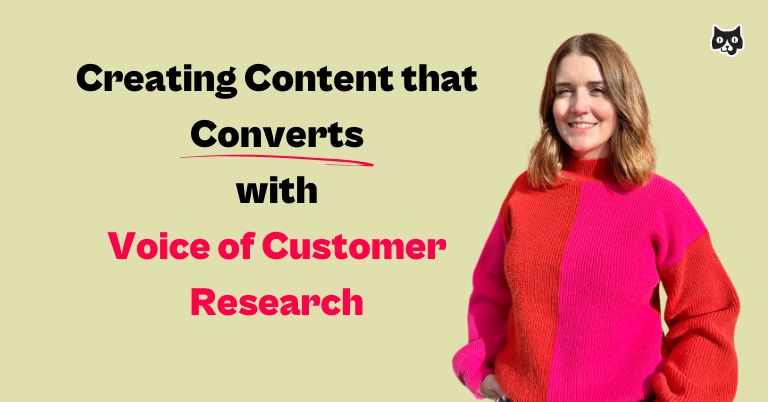Okay, I didn’t love the Barbie movie. I liked the idea of it. I’ve played the soundtrack on repeat. But did the climactic speech about womanhood bring tears to my eyes? Not really.
But Barbie was the highest grossing movie of 2023. It made over $1.4 billion at the box office and pushed Mattel’s doll sales up by 24%. It doesn’t matter whether I liked it or not. The target audience adored it.
Marketing fails when your audience isn’t the hero of the story. If Mattel made their movie for me, rather than working moms and their Gen Alpha daughters, they wouldn’t have sold so many dolls.
As content marketers, we need to make the customer feel seen. We need to win their trust by speaking their language, knowing their struggles, and helping them achieve their goals. That’s why I use voice of customer (VOC) research to make content that converts.
In this article, you’ll find my tips for researching VOC, including finding your customer online and organizing your research into a content writing treasure trove.
Wait, do you really have time for this?
Ideally, I want to refresh my VOC research one or two times a year, or every time the client launches a new feature. It takes time, but I’ve got no doubt it’ll help you create more engaging, targeted content that resonates with your audience.
Joana Wiebe, founder of Copyhackers, has loads of case studies on this. In one example, she found that using sticky copy from VOC research resulted in 400% more clicks and 26% more leads.
It’s no shortcut or hack, but it’s worth the time you put into it.
A deep understanding of the buyer’s mindset is what sets great content apart from AI and helps hit the E-E-A-T component of Google’s Search Quality Rater Guidelines. If that’s not something you have time for, you might need the support of an agency like Flying Cat. Getting inside the customer’s head is what we do.
“Testworthy copy isn’t sitting inside your head. Or mine. It’s in the hearts and minds of our customers and prospects. Our job is to lure it out, listen, and repeat it back in persuasive ways.”
— Joana Wiebe, founder of Copyhackers
You might see VOC software like Medallia or ResponseTek getting recommended for VOC. As far as I can tell, they’re better suited to product teams with a budget to throw around. I get by just fine with the tools I already use daily at work: Google Docs, Google Meet, and Otter.ai.
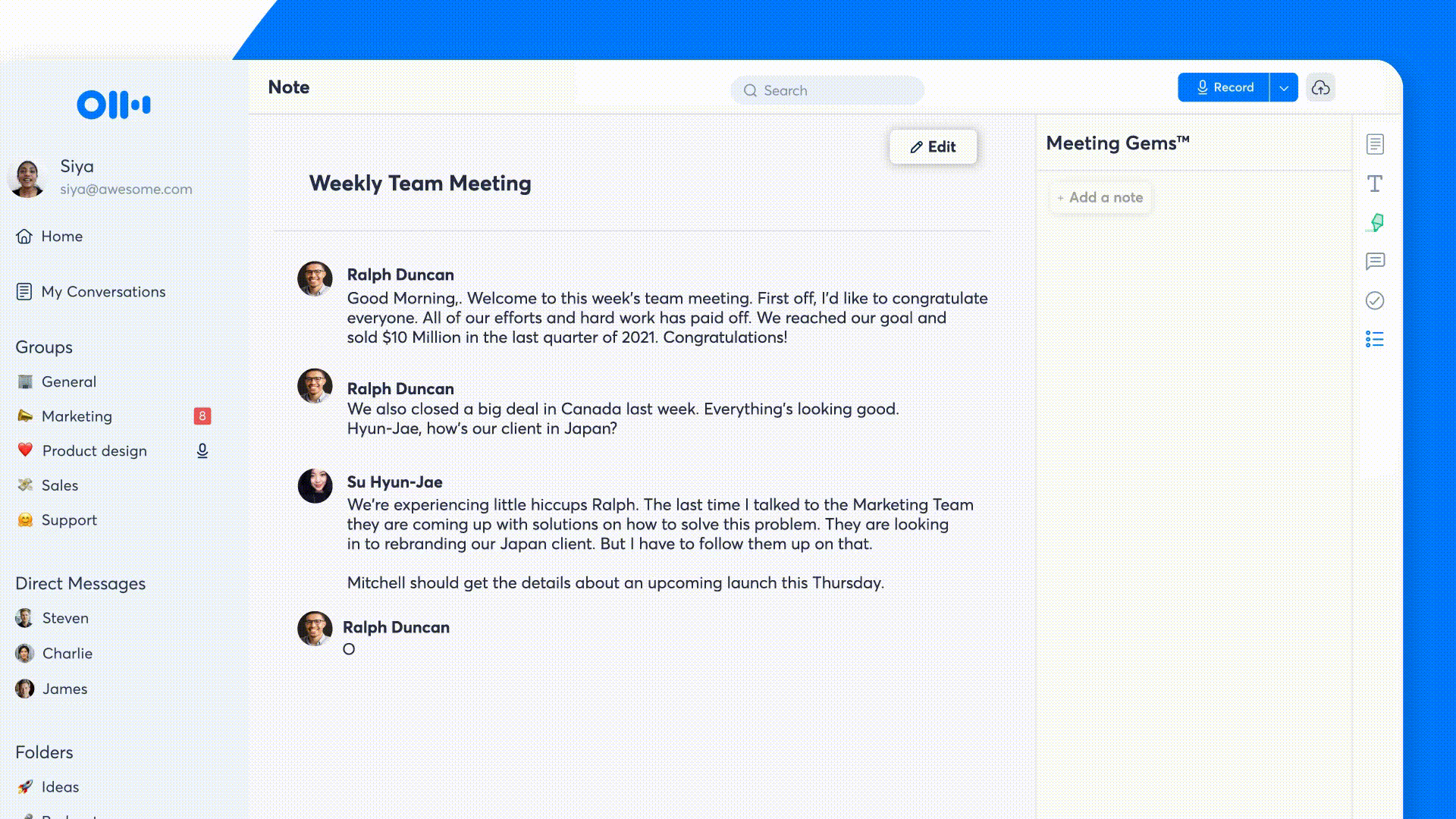
Source: Otter.ai
Finding the customer online
Ideally, you’ll jump straight on a call to interview customers that best fit your ICP. But that won’t work if the product is new to market—or if the target audience is too busy to spend 20 minutes talking to a marketer today.
When a face-to-face interview isn’t immediately possible, I take to the internet. I’m talking:
- Review sites
- Reddit threads
- Facebook groups
- Following relevant hashtags on
TwitterX
Kate Williams, a fellow content lead at Flying Cat, recommends Slack groups. She joined groups like RevGenius when working with Mixmax, a sales engagement platform for Gmail.
“At first, it was difficult to nail the Mixmax TOV,” says Kate. “But then, I joined a bunch of Slack groups for salespeople and started paying attention to how they spoke to each other.”
Kate helped deliver a 500% + increase in blog-assisted demo requests for Mixmax.
“The sales community shares a sharp, ironic, sometimes dark sense of humor that brings some light relief to a very tough, high pressure job,” she explains. Seeing that unfold online is what helped her tap into the VOC.
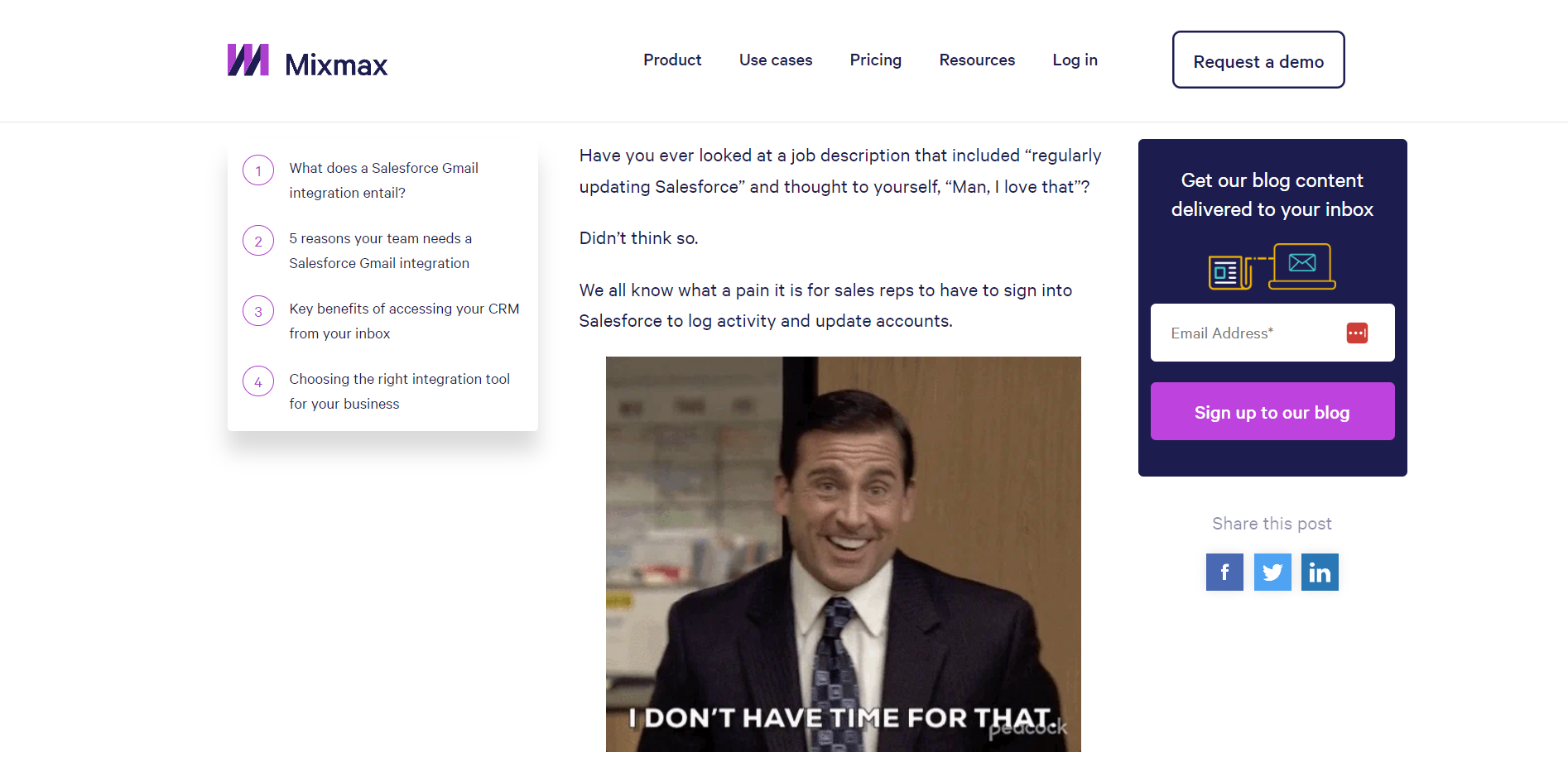
‘C’ for Competitor
During VOC research, I don’t just scour the internet for mentions of my client’s product. I also look for their competitors.
Sometimes, this means mapping out the client’s core product pillars and matching them up with the closest competitor. When I worked with a workforce management client in the Social Care space, the pillars looked like this:
| Product pillar | Competitors |
| Scheduling | Planday, Deputy, Birdie |
| HR & Payroll | The Access Group |
Next, I’m looking at review pages for each competitor. For SaaS products, G2 is my favorite review site because it tends to have a wider selection of quotes and you can sort by “Most Recent”. If you’re also in the SaaS space, I’d also check out:
- Capterra
- GetApp
- TrustRadius
- Software Advice
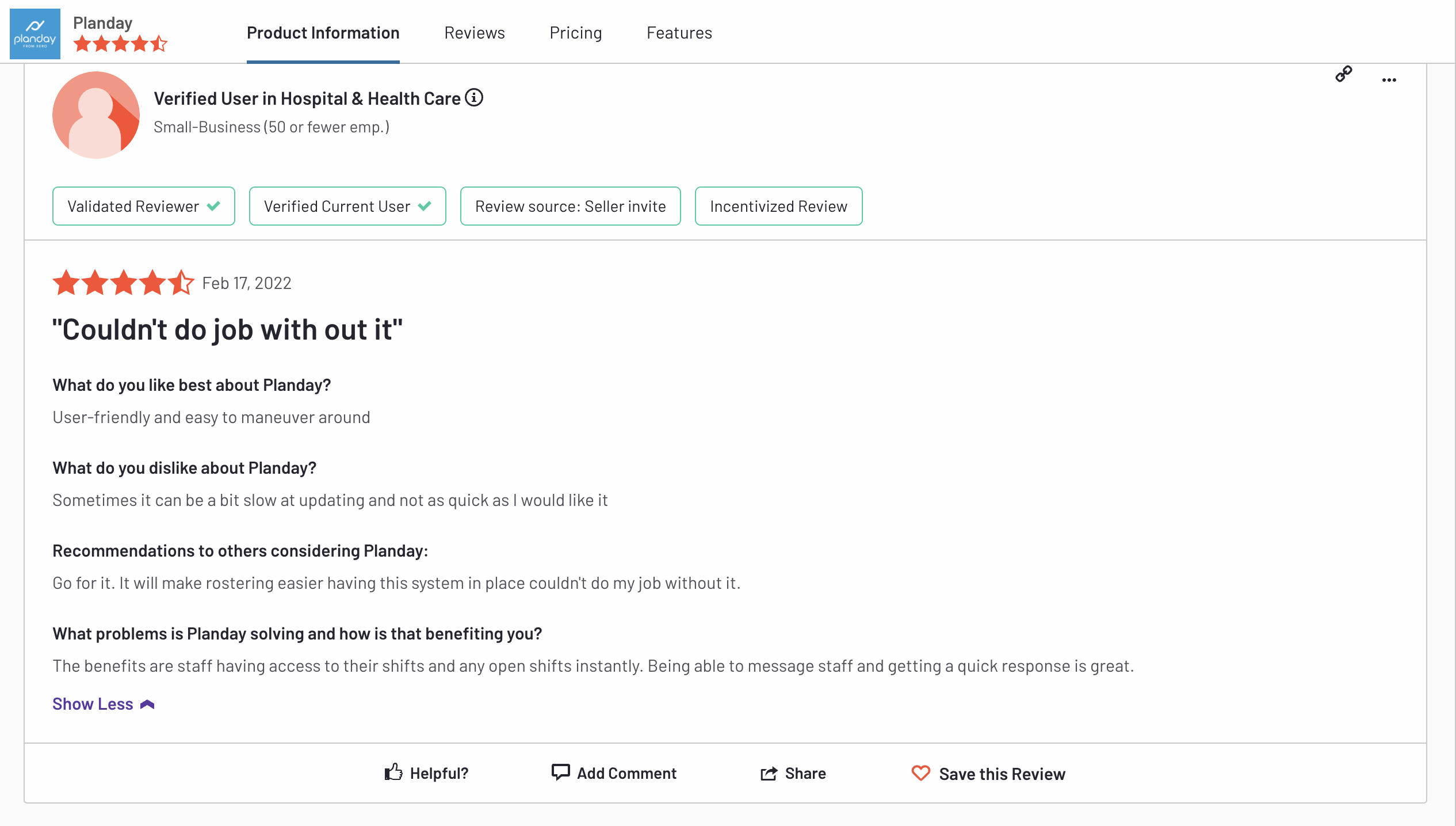
Source: Capterra
Mining reviews for sticky language
Looking at the reviews from the past year (any older will be redundant), I copy and paste direct quotes into a spreadsheet (more on this later!). The goal is to get a really broad spectrum of quotes so you can pick out common themes and sticky language.
What is sticky language? We’re talking memorable phrases that stick in your head after the moment has passed. Sticky language tends to be visceral, maybe even emotional, but simple to grasp.
In the Planday review above, I can see that user-friendliness is a key theme. The phrase “couldn’t do the job without it” feels sticky for me, so I’ll be saving that for later.
Going beyond review sites
Review sites are a start, but it’s not the same as seeing people interacting spontaneously with their peers.
For that, you need to be in discussion threads, forums, and social media groups—anywhere your customers spend time online. You can find discussions on almost any topic on Reddit, so that’s a good place to start.
💡 Pro tip: I love Joanna Weibe’s tip for collecting customer sentiments on a website’s thank-you page. Check it out if you’re producing content in-house or think you could convince your client to do the same.
I’ve been interviewing people professionally for five years or more. It’s not always easy to be totally switched on, listening actively throughout the entire thing. Here’s how I keep my focus and get better insights during VOC interviews.
Margin Notes
For years, I’ve used Otter.ai to record and transcribe calls live. It helps me focus on the interviewee rather than panicking about writing down every word.
That said, going over the transcript to pick out insights can take ages. Sometimes, I’ve listened back and been disappointed at how vague or surface-level the conversation seems in retrospect.
So, I’ve developed my method. While Otter still does its thing, I now take my own notes too. But I keep it simple. I note the main ideas and themes on one side of the page, and my follow-up questions on the other side. Some call this the Margin Notes method.
This approach helps me stay focused (no more glazed-over smile) but also stops me from interrupting the interviewee’s flow to ask my burning questions. Since I have them written down, I can wait til a natural pause without worrying about forgetting anything.
This same technique comes in handy when watching sales calls recordings—which are another great source of VOC quotes. Of course, you could just summarize them using AI. But there are two major drawbacks:
- You won’t get verbatim sticky language. AI has its own distinct voice and loves to make stuff up. You’ll still need to listen to the interview properly for pure VOC.
- You won’t get the emotional context. You’ll miss variations in tone, pauses, and facial expressions that give you extra context around what the customer is thinking or feeling.
Essentially, if you rely only on AI, you’ll miss the really juicy, visceral stuff that helps you tap into your reader’s feelings and conjure vivid imagery when you write.
My VOC interview framework
When I prep my interview questions, I’m thinking about revealing the customer’s goals, pain points, and wins with the product. I follow a framework like the one below.
Note: My example questions are tailored to a B2B audience since that’s our focus at Flying Cat.
- Explore their goals.
Find out what’s most important and what might motivate them to purchase. The insights are perfect for CTAs and copywriting frameworks like Desire, Outcome, Solution (DOS).
Example:- What are your top priorities at work right now?
- What does success look like? How do you measure it?
- Explore their pains.
Find out what challenges they face regularly and whether they’ve tried any other solutions apart from yours or your client’s product. This is key for product positioning copy and the Pain, Agitate, Solution (PAS) framework.
Example:- When you first discovered [product], what problem did you hope it would solve?
- Before finding [product] what other solutions did you use? What issues were you having?
- Pinpoint trigger event.
Zero in on the moment the buyer realized they had a problem to solve. Understand the emotional context and listen out for visceral language that could be used in persuasive copy.
Example:- Do you remember the first time you thought about needing a new solution?
- What was the breaking point that led you to try something new?
- Explore buying objections.
Gather specific details of what alternatives they considered and any anxieties, habits, or constraints. Again, this helps craft product positioning copy.
Example:- What other options did you consider? What stopped you from choosing them?
- Did anything almost prevent you from choosing our product?
- Measure the wins.
Identify the winning value propositions and how their lives have changed since they started using the product.
Example:- If you had to narrow it down, what was the #1 reason you decided to go with [product]?
- What’s the biggest win for you now you’re using it?
- Have you recommended it to anyone else? How did you describe it to them?
💡 Pro tip: The purpose of VOC interviews is to get real feelings, frustrations, and excitement. That requires a little icebreaking and rapport. I try to spend five minutes at the start of the call just talking to the interviewee like a person. Wearing a nice sweater? I’m gonna comment on it. Cute dog in the background? You bet I’m asking their name.
Deep dive questions
When your follow-up questions are good, you get better quotes, more sticky language, and a deeper understanding of the customer’s experiences.
I keep a reminder of these deep-dive questions near my desk:
- And why do you [care about / need / want] that?
- [When they use negative words] That seems to really bug you! Why is that?
- [When they use positive words] You seem pretty excited about that—why was that a big deal?
- What led to that decision? Can you walk me through your thought process?
Organizing your research
Once you have all those juicy insights on record, you need a way to refer back to them quickly during your writing process. I know some writers who like to print transcripts and go through them with a highlighter.
In truth, this is something every content creator needs to experiment with. There’s no “best” way to organize your research—only the way that works best for you.
At Flying Cat, we use a Google Sheets called the Customer Desire Map (CDM). It’s something that Maeva (Flying Cat’s CEO) introduced many years ago and I have iterated on many times while onboarding different clients.
To create a CDM, I copy-paste quotes directly from review sites, comment threads, or interviews, using the following columns to organize them according to type:
- Hopes and dreams. What are their goals? What do they wish they could do?
- Successes. What has the tool helped them achieve?
- Pains. What are their biggest challenges or pain points?
- Barriers and fears. What prevents them from achieving their goals? Why aren’t they using the solution?
Since I can’t scribble notes in the margins, I often add a “Themes” column to note any recurring ideas. I might also pick out phrases in bold for swipe copy later.
Here’s an example that’s still a WIP:
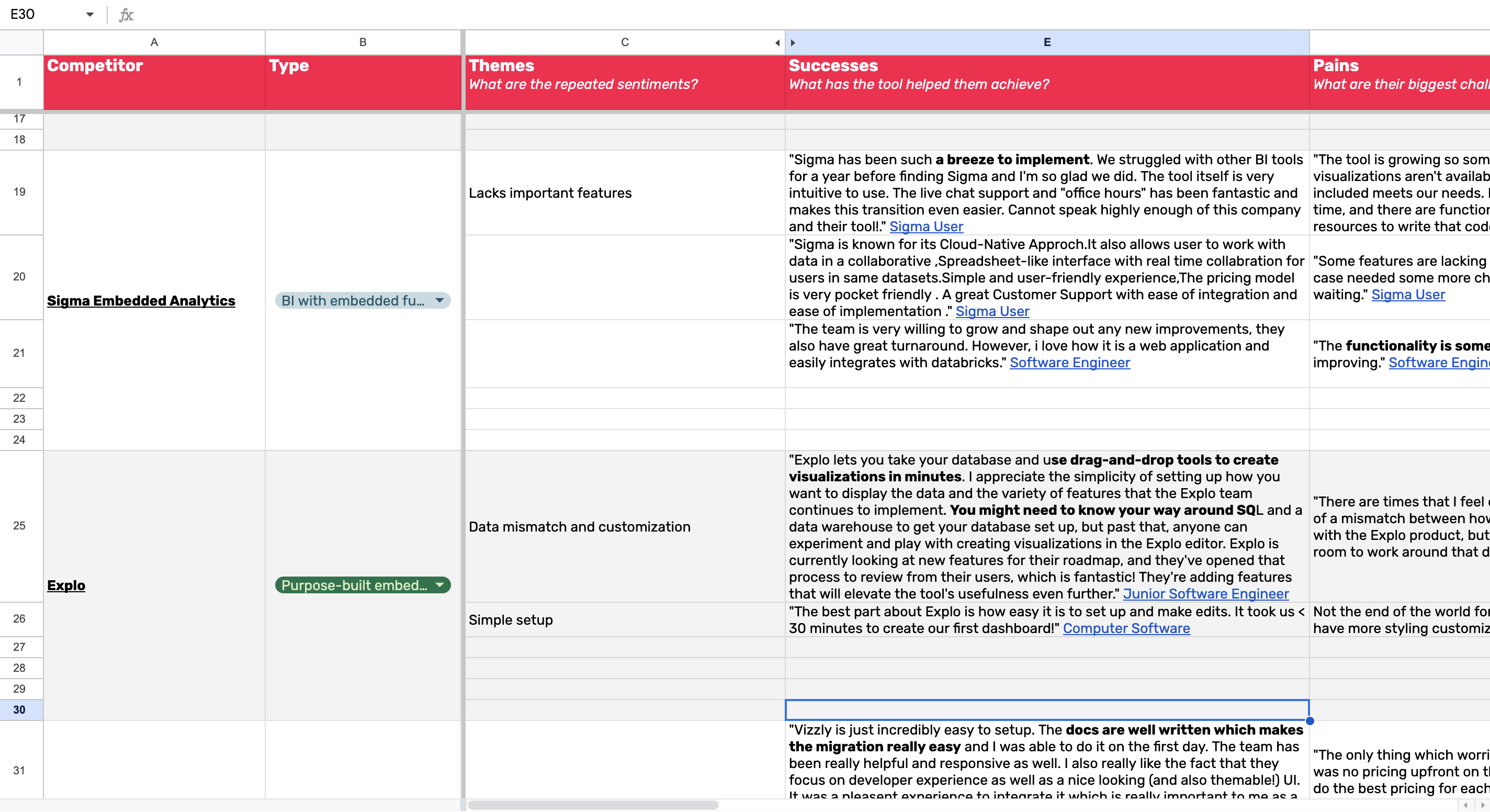
Source: Flying Cat
Right now, this example is organized by competitor products because we’re writing a lot of ‘alternatives’ pages for the client. That’s not always how I do it. Sometimes, it’s more useful to organize quotes according to different buyer personas.
For example, if the end-user ICP is a software engineer and the buyer ICP is a C-level, I’ll be sure to find quotes for both personas and separate them accordingly.
As I keep working on this project, I’ll populate a separate swipe copy tab with phrases and product copy that’s crafted based on sticky language and VOC quotes. I’m also contemplating adding conditional formatting to highlight specific quotes that relate to each theme. Too much?
Putting it all together
The golden egg of VOC research is always sticky language—those visceral phrases that put your brand right inside the mind of the reader and conjure real, relatable emotions.
These phrases can be used to elevate CTAs and headlines by using language that the audience speaks and giving them that “Aha!” of recognition when they see themselves in the content. When combined with copywriting frameworks like Attention, Interest, Desire, Action (AIDA), sticky copy becomes a powerful persuasive tool.
But it’s not just about quoting the customer back to themselves. VOC research helps understand where the reader is coming from: What their challenges are, their objections to purchase, their biggest priorities at work.
When I know these things, I have endless opportunities to write in a compelling way that meets my reader at their level. I can use examples that fit with the context of their role. I can tweak product positioning copy to showcase the value props that matter to them.
The result is helpful content that actually gets read—while building trust for the brand and winning leads.
